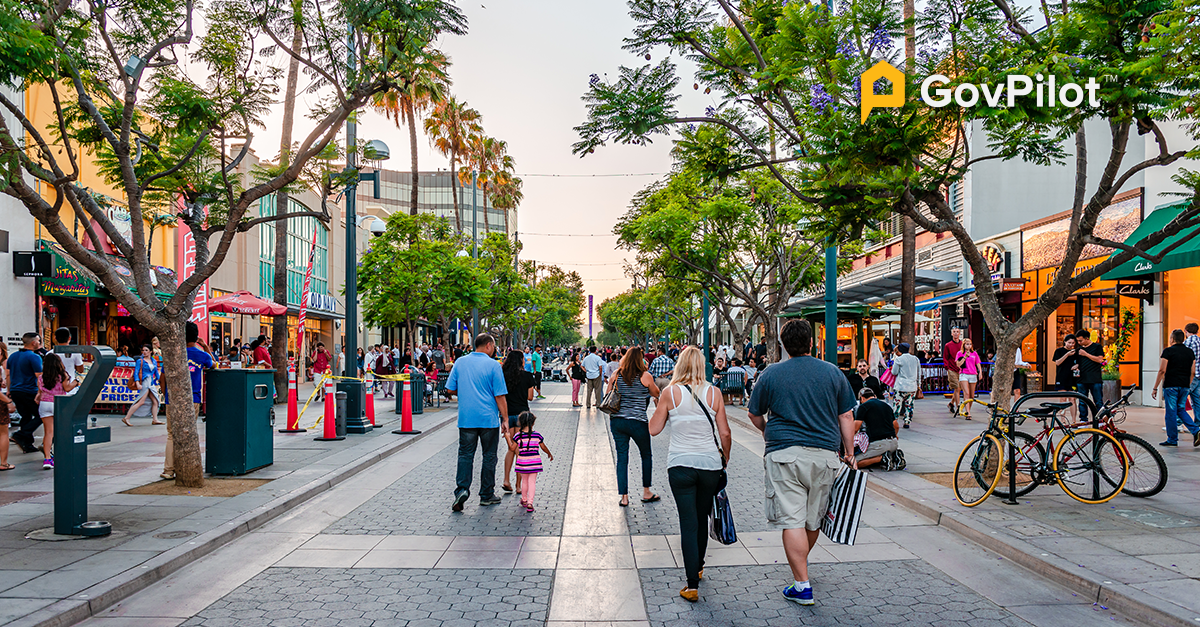Within the text of the US Infrastructure Bill, the Biden administration allocated over $20 billion towards “Safe Streets for All” and “Vision Zero” plans with the goal of improving safety measures across the country for pedestrians and cyclists, and not without good reasoning. Every year, 2% of deaths as a result of motor vehicle crashes are from bicyclists alone, and close to 6,000 pedestrians died at the hands of a motor vehicle in the most recent recorded year.
But how can your community keep pedestrians and cyclists safe? Follow along to learn how your municipality can improve its pedestrian zones and bike lanes to keep constituents safe, improve the attractiveness of the local environment, and increase property values.
What is a Pedestrian Zone?
As the name implies, a pedestrian zone is a designated area for people to walk within a city safely and securely. In most cases, these zones are considered car-free zones, in which no automotive vehicles are allowed.
What is a Bike Lane?
A bike lane is an area designated specifically for cyclists to use within a city environment. While bicycle lanes are often included on roads that cars are allowed to drive in, these zones offer enough open space for bikes to travel safely alongside moving automobiles.
While cycling remains a popular mode of transportation for citizens in major cities, secondary cities, and the suburbs, far too often the amount of space provided on major roads for cyclists is far too minimal.
What Does a Safe Pedestrian Zone Look Like?
Despite the massive amount of foot traffic in cities across the United States, there are far too few areas dedicated to pedestrian and cyclist traffic. Your government owes it to pedestrians to consider means of travel for those that opt to walk or bike.
Follow along for some examples of how you can update entire districts and improve the mobility and safety of pedestrians in your community:
Consider Partial Closures of Streets
In Columbia, the city Bogota famously closes off 76 miles of streets from 7 am to 2 pm on Sundays from motor vehicles, giving pedestrians the opportunity to make it to church safely without cars whizzing by.
Leverage your government data to look for patterns of when pedestrians are most active, so that you can consider appropriate times to curtail vehicle traffic.
Close Streets for Outdoor Dining and Shopping
As a result of COVID-19 and social distancing measures, many cities decided to shut down automobile traffic on busy streets or even their main street as a means to give restaurants and stores the chance to serve patrons when indoor dining and shopping was prohibited.
In many of these places, the expansion of businesses into the streets has been a wide-success and improved the local economies. With a sharp municipal planning strategy, urban planners can leverage a car-free development to open the roads to cyclists and pedestrians while simultaneously assisting local businesses and encouraging commercial activities. These pedestrian malls may be just the thing to drive economic activity and increased quality of life in your town far into the future.
Open Roads to Solely Buses and Pedestrians
In Manhattan, the New York City government has barred cars from using 14th street, making the formerly busy street a safe place for pedestrians and easy area for buses to travel through. This has given pedestrians a safe place to walk while simultaneously improving the speeds of public transit.
Consider which areas of your city can handle a total ban of car traffic and watch traffic decrease dramatically.
Set Incentives to Minimize Car Traffic
Come up with ways to incentivize a decline in the number of cars on the road, like a carpool lane, increased taxi and ride sharing app availability, improved public transportation, and easy means for pedestrians to access necessities like food and shops without driving.
Don’t Forget the Cyclists
We’ve all had that nervous feeling watching a cyclist ride squeeze between speeding cars and the sidewalk. Dedicate at least a 5 foot width on large roads to cyclists, with eye-catching signage and pavement markings to make it clear the area is a car-free zone.
Or consider turning over entire streets to bicyclists as several European cities including Amsterdam and Paris have done, to great effect. By encouraging large scale adoption of cycling you will reduce traffic congestion and pollution, while increasing the health and wellbeing of your citizens.
How Will Expanding Pedestrian Zones Positively Impact Your Community?
Making the move away from car-centric infrastructure can be a huge positive for your community as a whole:
-
The pedestrianisation of your city means they'll be less cars on the road and fewer deaths as a result of automotive accidents.
-
Heavy foot traffic in areas with shopping and dining means that local businesses will see a boost in income.
-
Let those that live in the city enjoy more peace and quiet with a reduction in noise pollution
-
More constituents opting to walk or bike instead of drive will result in a drop of gas emissions and a big win in the fight against climate change.
-
More walking and biking and less driving means community members will collectively be healthier and have a higher quality of life.
- More access to travel around town without the need for a car will open citizens up to new job opportunities and community resources they may not have been able to access before; this increases upward mobility in your community.
How Can Your Local Government Expand Its Pedestrian Zones and Bike Lanes?
With the Safe Streets for All and Vision Zero programs laid out in the US Infrastructure Bill, cities across the country will have the opportunity to leverage federal funds to improve their pedestrian street infrastructure. To make it happen, your community will have to build-out a comprehensive safety plan and apply with the federal government to receive funds.
Government management software can play a critical role in your community’s development of safer streets for pedestrians. Digitized permitting software means that zoning permits for pedestrian zones can get approved more quickly, and that local businesses can apply for business registration online to get their outdoor dining and shopping set-up on streets with a lot of foot traffic.
To learn more about how local government software like GovPilot can help, book a free consultation.
Pedestrian Zone FAQs
Why Are Pedestrian Zones Important?
Thousands of pedestrians die a year at the hands of automobile drivers. Pedestrian zones are a safe space for Americans to travel by foot safely without being at risk of getting struck by a car.
With proper municipal planning, these zones are a great place for businesses to set up shop outside, meaning that they can be a fantastic boost to your local economy as well. Increased public activity in these spaces will also necessitate a need for beautification and these new pedestrian precincts can be used to plant new vegetation such as trees, flowers, and grass areas to further improve quality of life and resilience to flooding events.
Why Are Bike Lanes Important?
Modes of transport like cycling, kick scooters, and inline skates are a healthy and environmentally friendly way to get around the city. Unfortunately, failure to dedicate areas of major roads specifically to bikers put them at serious risk of being struck by a car. Opening up busy streets to cyclists can decrease the number of cars on the road overall, and can ensure that community members can get from point a to point b without a fear of being hit.
How Can Your City Improve on Pedestrian Zones and Bike Lanes?
The US Infrastructure Bill dedicated billions of dollars towards improving public infrastructure for pedestrians and cyclists. If your city takes the time to make a detailed plan for improving pedestrian zones, the federal government will provide the funds to make it happen.
Consider additional ways to improve your local government and community:
Disaster Resilient Infrastructure: What is It and Why It's Needed
Local Government Flood Mitigation & Disaster Planning
Local Government Wildfire Mitigation & Disaster Planning
Building Inspections 101: How Local Governments Can Ensure Public Safety
Public Sector Recruiting: How to Hire Talented Government Workers
What the American Rescue Plan Means for Your Local Government
Sources:
https://www.nlc.org/wp-content/uploads/2020/01/CS_PedestrianReport_Final_WEB-1.pdf
https://nacto.org/publication/urban-bikeway-design-guide/bike-lanes/







